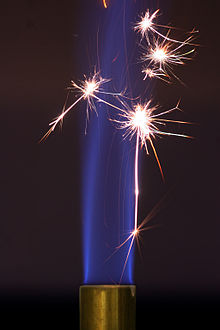Wikipedia:Featured picture candidates/Incandescence

This image appears in the article Incandescence. I took the picture, and chose to nominate it for the following reasons. First the illumination for the image is provided in part by incandescence itself: the sparks are visible because of the incandescence of the metal embers composing them. Moreover, the exposure time is long enough to show some very dynamic behaviors such as 1) the sequential fragmentation of larger embers into smaller ones, 2) the cooling of the embers as manifest in their color shift from white to orange to red (see blackbody), 3) small embers being whisked upward by the flame's convection, while heavier ones fall, and 4) that neato little ember that bounces off the bunsen burner top.
- Nominate and Support. - Debivort 04:41, 18 December 2005 (UTC)
- Comment Are you sure the blue is carbon incandescence? AFAIK that is yellow, not blue, and it is seen when you lessen the air flow to the flame. Black-body radiation starts in the red region of the spectrum. So, the blue is something else. As the article Flame states: Complete combustion of gas has a dim blue color due to the emission of single wavelength radiations from various electron transitions in the excited molecules formed in the flame. If you agree, please correct the text in the incandescence article, too. --Janke | Talk 09:14, 18 December 2005 (UTC)
- Thanks for the correction! Have revised the text both here and there. This actually reminds me that the photo would be a decent image for the Flame article too because the sparks portray the concept of an activation energy needed to initiate a flame. Debivort
- You forgot to change the photo's caption here, so I copied it. BTW. I support - it's a beautiful photo. --Janke | Talk 07:28, 19 December 2005 (UTC)
- Thanks for the correction! Have revised the text both here and there. This actually reminds me that the photo would be a decent image for the Flame article too because the sparks portray the concept of an activation energy needed to initiate a flame. Debivort

Oppose. Pretty pic, but I think the other image in the Incandescence article does a better job at illustrating the concept of glowing due to heat, which probably is the reason it is already featured. --Dschwen 16:28, 18 December 2005 (UTC)- The other is an excellent picture. What is the consensus regarding using the same image in multiple articles? It could be easily moved to flame, or even blackbody. Thoughts?Debivort 00:41, 19 December 2005 (UTC)
- Using the same image in multiple articles is no problem whatsoever, infact it should be encouraged if the image can illustrate multiple articles. I'll leave it to others who know about this area to add it, but if you feel it illustrated the above mentioned articles by all means add it. Raven4x4x 01:39, 19 December 2005 (UTC)
- The other is an excellent picture. What is the consensus regarding using the same image in multiple articles? It could be easily moved to flame, or even blackbody. Thoughts?Debivort 00:41, 19 December 2005 (UTC)
- Support, in contrast to the above reason, I think it is an excellent illustration of the concept. This photo was perfectly timed to receive this phenomena, an exceptional photograph. -- Natalinasmpf 16:43, 18 December 2005 (UTC)
- No, the incandescence can only be seen in the tiny overexposed sparklets. There is no perfect timing involved, just opening up the shutter and blowing some iron filings into the flame. The relation between temperature and color does not become clear in the picture and the flame having such a prominent role in the frame could lead to misunderstanding the whole concept. --Dschwen 11:19, 20 December 2005 (UTC)
- I am sympathetic to Dschwen's concerns, and think that one way to adress them is to also include the image in the Activation Energy article, which currently has no illustrations, and is more directly related, given that steel embers provide the activation energy for lighting the burner. Here is the caption I provided there (The sparks generated by striking steel against a flint provide the activation energy to initiate combustion in this bunsen burner. The blue flame will sustain after the sparks are extinguished because the continued combustion of the flame is now energetically favorable). I am open to the possibility of switching the article affiliation of this FPC to activation energy, assuming this doesn't violate any FPC taboos. Cheers Debivort 05:31, 21 December 2005 (UTC)
- That's a good solution. The pic is much better off in this article. In fact in this context I'll happily support it. --Dschwen 08:44, 21 December 2005 (UTC)
- I've added the image to Activation energy. The new caption is shown in the third image. Debivort 21:36, 21 December 2005 (UTC)
- Support Flcelloguy (A note?) 21:40, 21 December 2005 (UTC)
- Support Eynar Oxartum 06:16, 25 December 2005 (UTC)
- Support now that is has found a good article home. enochlau (talk) 15:18, 22 December 2005 (UTC)
- Support - yeah, nice.--Deglr6328 00:02, 27 December 2005 (UTC)
Promoted Image: Incandescence.jpg. I'm glad to see a suitable article could be found. Raven4x4x 04:09, 1 January 2006 (UTC)
